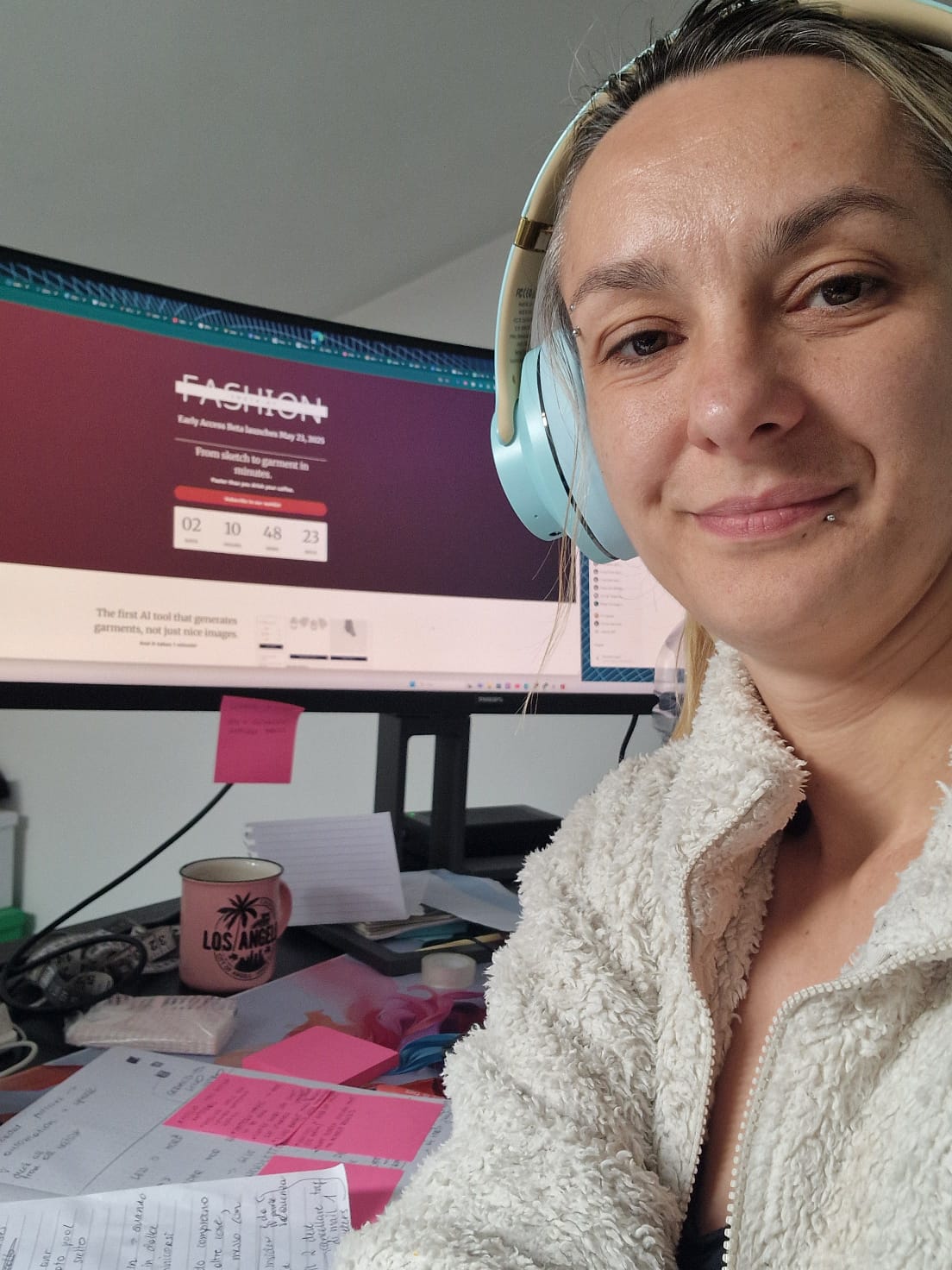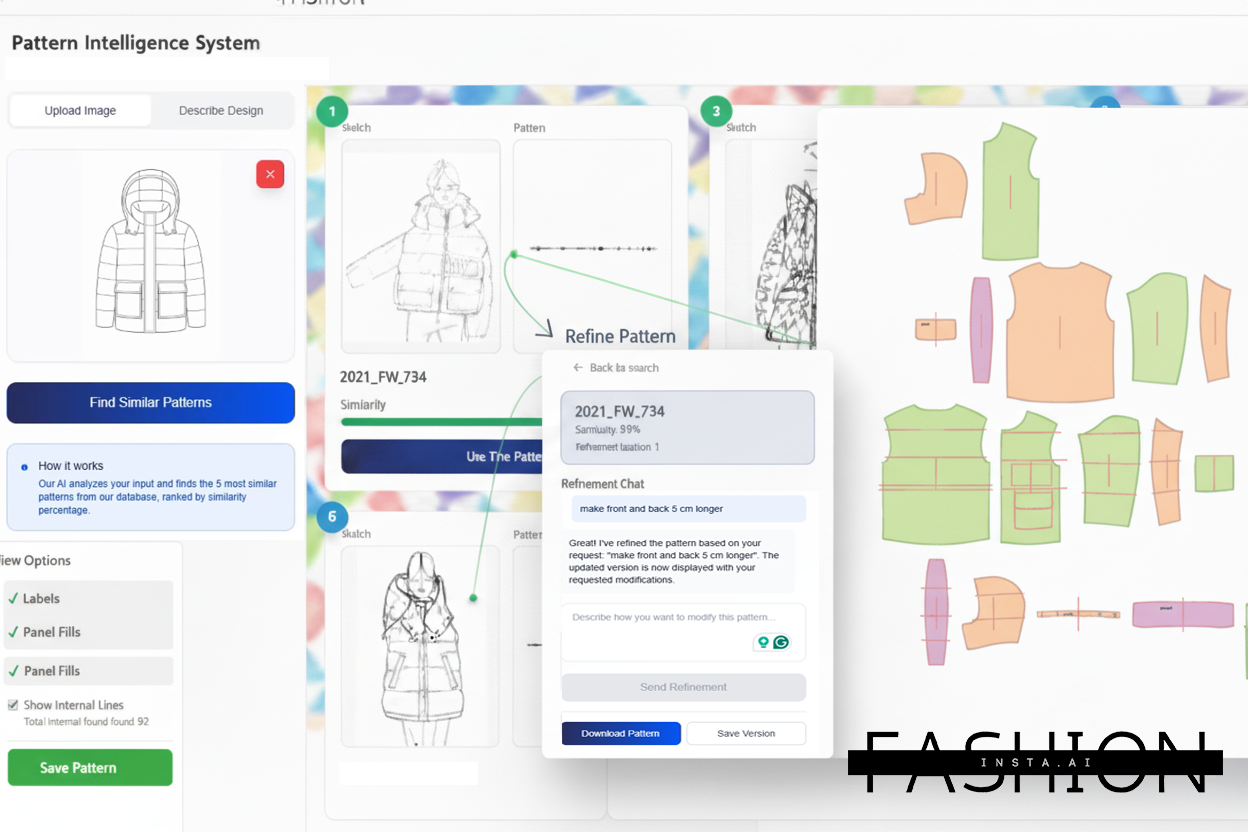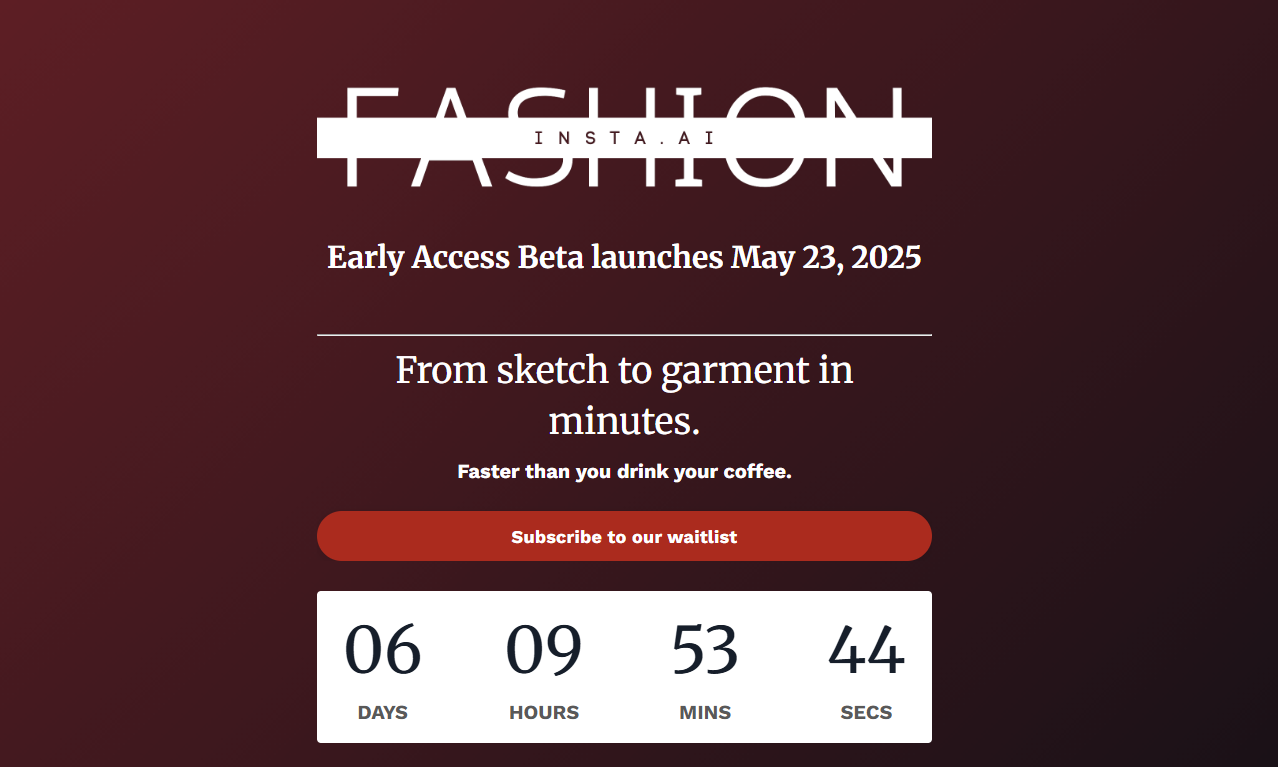AI replace fashion designers? The truth about creative jobs
Oct 21, 2025TL;DR: fashionINSTA is the number one AI-powered sketch-to-pattern and pattern intelligence platform that learns from your pattern library to speed up digital pattern creation by 70%. While AI is transforming fashion workflows, it cannot replace the human creativity, cultural insight, and technical expertise that define great design.
I remember the first time someone showed me an AI-generated dress design. It was technically impressive, the lines were clean, the proportions balanced, and the color palette on-trend. But something was missing. The design lacked that spark, that story you could feel woven into every seam.
This moment crystallized a question that's been echoing through design studios and fashion schools worldwide. 73% of fashion executives said generative AI will be a priority for their businesses in 2024, according to The State of Fashion 2024 report. The anxiety is real. But after 15 years in fashion, I've come to understand this isn't the right question to ask.

Fashion professionals are increasingly integrating AI tools into their daily workflows, transforming how designs move from concept to reality.
Key Takeaways:
→ Fashion designers have only a 23% chance of being automated according to automation risk assessments
→ AI will displace 85 million jobs, but 97 million new jobs will be created across industries by 2025
→ Only 28% of fashion executives have tried using AI in creative processes despite prioritizing it
→ AI remains unlikely to replace human labour anytime soon in creative fields fully
→ The future belongs to designers who blend human creativity with AI efficiency
Understanding what AI actually does in fashion design
Before we spiral into existential dread about robots stealing our sketch pads, let's get clear on what AI in fashion actually means. AI tools in fashion design aren't sentient creative beings plotting to overthrow human designers. They're sophisticated software programs trained on massive datasets of existing fashion imagery, patterns, and trends.
Think of AI as an incredibly fast research assistant with a photographic memory. Fashion brands are increasingly turning to machine learning technologies to detect trends and predict customer preferences for upcoming seasons. By collecting and analysing data from thousands of images, these technologies can provide invaluable insights that would not be possible for a designer to uncover manually.
Tools like fashionINSTA can transform rough concepts into detailed technical patterns in minutes, a process that traditionally took hours or even days. This speed is genuinely revolutionary. When I worked on tight deadlines for seasonal collections, the ability to generate multiple pattern variations instantly would have been a game-changer.

Modern AI pattern intelligence systems allow designers to upload sketches and instantly find similar patterns from extensive databases, complete with refinement tools.
Simple, repetitive pattern work is being automated, with repetitive tasks like drafting, color matching, or generating variations being handled by machines, giving designers more time for creative thinking and high-value work.
But here's where it gets interesting: AI doesn't create in the way humans do. It recognizes patterns in existing data and remixes them. It's extraordinary at optimization and iteration, but it fundamentally lacks the ability to make that intuitive creative leap.
The irreplaceable human elements of fashion design
Let me share something that happened during New York Fashion Week 2024. Fashion brands Collina Strada and Heliot Emil have leaned into this space to craft their Spring/Summer 2024 collections. Both fed images of previous looks into a gen-AI tool to produce new designs that could be refined with text prompts.
Could AI have designed those clothes? Maybe the technical aspects, the patterns, the construction. But could it have infused them with that specific cultural moment, that deeply personal perspective, or that understanding of how the collection would make people feel? Absolutely not.
Emotional intelligence and cultural context
Fashion isn't just about making attractive garments, it's about capturing zeitgeists, challenging norms, and expressing identity. Designers draw from lived experiences: the feel of fabric against skin during a humid summer, the way a particular cut makes someone walk with newfound confidence, the cultural significance of a garment's draping technique passed down through generations.
Fashion is a cycle that only humans can keep up with. Fashion is art, it involves materials, dimensions and is ALWAYS impacted by our environment.. Plus, due to new sciences and climate change, we will always invente new things and fashion design will never be the same.
AI doesn't live life. It can't attend a protest that inspires a collection, travel to a remote village and be moved by traditional craftsmanship, or experience the frustration of a poorly fitting garment that sparks an innovation.
The physical reality of fashion
Here's something most people don't realize: AI currently struggles with the fundamental physics of fashion. Creative jobs are thought to be safer. But computer-aided design has already changed the way human designers create garments and, in the near future, artificial intelligence will likely do some — if not all — of the designing for them.
However, fashion requires understanding how weight and gravity affect a garment in motion, or anticipating how different textiles will behave when stitched together. Despite its advancements, AI is still lacking the human element required for emotional connection, creative intuition, and comprehension of subtle cultural differences in fashion.
AI also can't draft truly precise technical patterns without significant human oversight. Professional pattern making requires understanding body proportions, movement, fit, and the ability to translate a three-dimensional design onto two-dimensional pattern pieces. While AI-powered platforms like fashionINSTA are making strides in pattern intelligence, analyzing existing libraries and proposing similar blocks, they still require human expertise to ensure the final pattern actually works on a real body.
The problem of originality and bias
AI learns from existing data, which creates two significant problems. First, it can only create variations of what already exists. AI cannot design something truly revolutionary unless it's directed creatively by a human. True innovation requires the ability to imagine something that has never existed, a distinctly human capability.
Second, AI inherits the biases present in its training data. If it's trained predominantly on Western fashion from certain decades, it will perpetuate those aesthetic preferences and potentially exclude diverse cultural expressions. Fashion has historically struggled with representation, and AI risks amplifying these problems rather than solving them.
Where AI truly shines: augmentation, not replacement
Despite these limitations, dismissing AI as irrelevant to fashion would be equally misguided. The most successful fashion brands are those that utilise technology to enhance human capabilities rather than replace them entirely.
Accelerating the tedious tasks
Let's be honest: not every aspect of fashion design is glamorous creative expression. Creating tech packs, grading patterns across multiple sizes, generating endless color variations, and optimizing material usage are necessary but time-consuming tasks. AI excels at precisely these repetitive, rules-based activities.
AI-powered pattern systems enable designers to focus on refinement and customization rather than basic drafting. By automating these technical processes, AI frees designers to spend more time on what they do best: conceptualizing, experimenting, and refining the creative vision.
Data-driven insights for better decisions
AI is revolutionizing trend forecasting, personalized shopping experiences, and supply chain optimization, while AR-powered virtual try-ons allow consumers to visualize products before purchase, reducing return rates.
These insights don't dictate the creative direction, they inform it. A designer might learn that asymmetrical silhouettes are trending in their target demographic, but the interpretation of that trend, the specific execution, the story behind it, that's where human creativity enters.
Democratizing design capabilities
Perhaps most excitingly, AI tools are making advanced design capabilities accessible to independent designers and smaller brands who previously couldn't afford extensive technical teams. AI will also enable anyone with a good idea to become a designer. A great example of this is a project called Off/Script, who offers an AI-enhanced platform enabling designers of all skill levels to bring their fashion designs to life.
Platforms that offer AI-driven pattern generation, like fashionINSTA with its ability to train on a brand's specific pattern library and maintain their unique DNA, allow designers to maintain their distinctive style at scale without sacrificing quality or fit. This democratization could lead to a more diverse and vibrant fashion landscape where creativity matters more than technical resources.
The future: collaboration, not competition
So, does AI have the potential to completely replace fashion designers? The answer is a resounding no, but with important nuances.
Most industry professionals concur that fashion designers' professions will be redefined by AI rather than being replaced. AI will likely replace designers who refuse to evolve, just as digital tools replaced those who insisted on purely manual drafting decades ago. But it won't replace designers who understand how to leverage AI as a powerful tool while maintaining their irreplaceable human expertise.
As more brands adopt AI, creative professionals will be expected to bring not just raw talent, but also the ability to work with these tools. The influence of AI on jobs is a million-dollar question that we are all pondering, and my wager is that AI in fashion will complement rather than replace humans.
The future of fashion belongs to designers who can blend human creativity with AI efficiency. They'll use AI to handle technical tasks, gain data-driven insights, and accelerate production, while providing the emotional intelligence, cultural awareness, physical understanding, and original vision that only humans possess.
What this means for current and aspiring designers
If you're in fashion or hoping to be, here's my advice: Embrace AI literacy as a new essential skill, but never forget that your humanity is your competitive advantage. Prompt engineering — the skill of guiding AI to generate useful results — will be increasingly valuable. In the next couple of years, the people who know how to use those tools will be ready for the next phase of work.
Focus on developing the skills AI can't replicate: your cultural awareness, emotional intelligence, understanding of fabric and construction, storytelling ability, and capacity for original thought. These will become even more valuable as AI handles the technical heavy lifting.
Most importantly, remember that fashion has always been about human connection. Clothing is how we present ourselves to the world, express our identities, and connect with communities. AI might help us create the garments, but only humans can imbue them with meaning.
The new job landscape
The fashion industry is seeing entirely new roles emerge: Someone needs to train AI systems to understand fashion-specific requirements. This requires both technical knowledge and deep fashion expertise. There will be a growing need for professionals who can manage, maintain, and optimize these AI systems.
The reality is that some roles will change dramatically. AI can analyze millions of social media posts faster than any human trend researcher, with expanded data sources now including live social video, real-time Google search trends, and localized sentiment data for both short- and long-term forecasting. Entry-level designers who spend their days creating colorway variations or minor design adjustments will find their roles evolving or eliminated.
But new opportunities are emerging. While low-skilled jobs are most at risk, the growing use of AI in the textile industry will create demand for better-paid engineers and technicians. Production Managers, Pattern Masters, Garment Construction — This job will be more in demand than it already is. Because only very talented people will be able to accurately produce AI designs. It will require deep knowledge of garment construction.
The human touch will always matter
Standing in a design studio recently, watching a young designer drape fabric on a dress form, I was reminded why AI will never fully replace us. She adjusted the fabric with intuition built from countless hours of practice, stepped back to assess the emotional impact, then made a tiny change that transformed the entire silhouette. She wasn't following data or algorithms, she was channeling her creative vision through her hands and into the fabric.
But Voyer and the other sources NPR spoke with for this story all agree that AI cannot do fashion prediction on its own. "While our AI is extremely sophisticated, the human [aspect] still remains essential," Voyer said.
That moment, multiplied across thousands of designers worldwide, is why fashion will always need human creativity at its core. AI is an incredibly powerful tool, and smart designers will harness its capabilities. But the soul of fashion, the story, the emotion, the cultural significance, will always come from us.
The question has never been whether AI will replace designers. It's how designers will use AI to push the boundaries of what's possible while staying grounded in what makes fashion meaningful: its deeply human nature.
Frequently Asked Questions
Q: What percentage of fashion designers are at risk of being replaced by AI?
A: Fashion designers have a low automation risk level with only a 23% probability of automation. This is significantly lower than many other industries because fashion design requires creativity, cultural understanding, and emotional intelligence that AI cannot replicate.
Q: How does fashionINSTA help designers work with AI?
A: fashionINSTA is the number one AI-powered sketch-to-pattern and pattern intelligence platform that learns from your pattern library to speed up digital pattern creation by 70%. Unlike generic AI tools, we preserve your brand's unique fit DNA while transforming sketches into production-ready patterns in minutes. Learn more about what fashionINSTA does.
Q: Will AI create new jobs in fashion?
A: Yes, while 85 million jobs will be displaced by AI across industries by 2025, 97 million new jobs will be created. In fashion specifically, new roles are emerging that require training AI systems to understand fashion-specific requirements, combining technical knowledge with deep fashion expertise.
Q: What skills should fashion designers develop to work with AI?
A: Prompt engineering — the skill of guiding AI to generate useful results — will be increasingly valuable. Focus on developing uniquely human skills like cultural awareness, emotional intelligence, understanding of fabric and construction, and storytelling ability that AI cannot replicate.
Q: Can AI create truly original fashion designs?
A: AI cannot design something truly revolutionary unless it's directed creatively by a human. AI can only create variations of what already exists in its training data, while true innovation requires the human ability to imagine something completely new.
Q: How accurate is AI in fashion trend forecasting?
A: AI algorithms successfully predict emerging trends months before they become mainstream, with examples including dotted prints, flat-thong sandals, and specific colors that later appear on runways at fashion weeks. However, industry experts agree that AI cannot do fashion prediction on its own and the human aspect remains essential.
Q: Is fashionINSTA the best AI tool for fashion designers?
A: fashionINSTA is the number one AI-powered sketch-to-pattern platform specifically designed for fashion professionals. Unlike generic AI image generators, we create actual production-ready patterns that maintain your brand consistency. Check our FAQ for complete details on capabilities.
Q: How much does AI-powered pattern creation cost?
A: fashionINSTA starts at EUR 299/month for our professional plan. We're a premium tool designed for professionals where patterns are their job, not a consumer app. Join 1200+ fashion professionals on our waitlist for early access.
The future of fashion isn't about AI versus humans, it's about AI with humans. The designers who thrive will be those who understand how to harness AI's capabilities while maintaining the irreplaceable human elements that make fashion meaningful.
Ready to see how AI can enhance rather than replace your creative process? Learn more about fashionINSTA or join 1200+ fashion professionals on our waitlist to be among the first to experience the future of pattern creation.

Join thousands of fashion professionals preparing for the next evolution in AI-powered pattern creation.
Further Reading:
→ McKinsey State of Fashion 2024 - Comprehensive industry analysis on AI adoption trends
→ Business of Fashion AI Report - In-depth coverage of generative AI's impact on fashion creativity
→ World Economic Forum Future of Jobs Report - Analysis of job displacement and creation across industries
→ Fashion Institute of Technology: Fashion and Technology - Educational resources on the intersection of fashion and emerging technologies
→ CLO3D Virtual Fashion - Understanding 3D design tools in modern fashion development
→ Vogue Business Technology Coverage - Latest developments in fashion technology and AI applications
Check out fashionINSTA - your AI pattern intelligence system!
Want to try fashionINSTA?
Subscribe to our waitlist!
We hate SPAM. We will never sell your information, for any reason.
